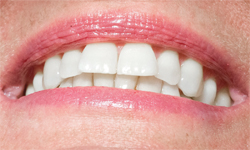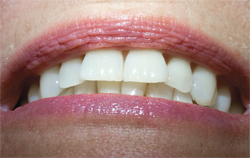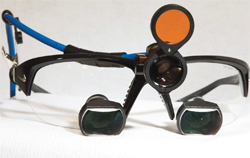
Shine a Light
Coaxial illumination can help dental professionals improve their field of vision while also providing ergonomic benefits.
Ergonomics has revamped the dental office and drastically improved the physical health of dental professionals in the workplace. Magnification loupes are a well-known, evidence-based ergonomic tool that improves clinicians’ posture. Coaxial illumination, often used in tandem with loupes, is not as well researched as magnification, but it can offer ergonomic benefits as well. Originally designed for surgeons, coaxial illumination has been used in the dental arena since the 1980s. It provides a light source that is parallel to the sight line, which helps prevent shadows in the mouth that impede a clinician’s view.1

Also called headlights, earlier coaxial illumination models used fiber optic, halide, halogen, and xenon lights.2 New versions include a light emitting diode (LED). LED technology has drastically changed the world of lighting, with applications ranging from Christmas lights to car headlights. LEDs are small lightbulbs in an electrical circuit that produce a full spectrum of white light, without creating excessive heat, through the movement of electrons.3 They are incredibly long-lasting with a life expectancy of 50,000 hours.4 If used during a typical 32 hour work week in the dental office, LED lights will last approximately 30 years.
FEATURES
Coaxial illumination enhances magnification, improving the field of vision. Headlights increase operator comfort by providing a clear field, reducing eye strain, and encouraging a neutral position by eliminating the need to hunch over to improve vision.5 Inadequate lighting makes it difficult to assess patient needs and deliver quality care. In addition, it can lead to eyestrain and poor posture.6 The intraoral working field should be a minimum of three times brighter than surrounding areas1 and more light is needed when performing close-up, detailed tasks. Headlights offer the ability to adjust the intraoral lighting to meet the appropriate contrast with adjacent structures.

Coaxial illumination can be key for dental hygienists who have declining vision. The aging process increases the lighting needed to perform detailed tasks.7 The desired level of brightness varies according to the operator’s age as well as the size of the objects being examined.1 The adjustment knob on the battery pack allows the practitioner to adjust the brightness for different procedures to achieve optimal visibility and comfort.1
Working with the appropriate amount of light is important, but esthetic work requires viewing teeth in a natural light. Gone are the days when the overhead light had to be turned off in order to obtain a shade match on teeth. LED headlights provide a much more natural color than overhead lighting. Figure 1 and Figure 2 demonstrate the difference in color when using an LED headlight vs an overhead light. The LED displays a natural light comparable to sunlight while the overhead lighting creates a yellow cast.5
Coaxial illumination systems are now quite compact, fully portable, and hands-free. Headlights remove the need for an overhead light, and they work during power outages. Because they rarely require adjustment during treatment, headlights may help dental professionals save time during procedures. Their use may also reduce stress in the muscles of the arm, shoulder, and upper back caused by lifting the arm repeatedly to adjust an overhead light. Coaxial illumination lights all areas of the mouth equally, even areas typically covered in shadows, such as the back of the mouth.
ERGONOMIC BENEFITS

Headlights facilitate ergonomically correct posture by providing shadow-free illumination that allows clinicians to remain in a neutral position instead of leaning forward.1 Wearing a headlight eliminates the need to bend the neck, which creates poor posture and leads to musculoskeletal injury. Coaxial illumination also provides optimal lighting that is parallel to or within 15° of the clinician’s line of sight.8 This can be difficult to achieve with overhead lighting.
CONCERNS
Clinicians may be leary of trying something new to them, although coaxial illumination has been around for decades. Asking other dental colleagues about their experience with headlights is helpful as is speaking with manufacturers about their products. Cost is a factor, as headlights range from as low as $400 to as high as $2,000. Patients who have not seen a dental hygienist wearing a headlight may be initially surprised. To minimize the view of the cord and battery pack, run the cord under a lab jacket or top while keeping the battery pack attached at the waist (Figure 3). The ability to adequately disinfect a headlight is also a concern. However, headlights reduce the risk of cross-contamination because the light is not adjusted during treatment so there is no hand-to-light transfer of pathogens. The light can be turned on and off before and after donning gloves. To eliminate potential aerosol contamination, headlights can be disinfected. The manufacturer instructions should be followed to effectively disinfect without damaging the system.6
PRODUCT CONSIDERATIONS

When choosing a headlight system, several factors should be considered. The light color temperature (the color of the light emitted by the LED) determines how closely the lighting resembles natural sunlight as opposed to casting a yellow or blue shade over the working field.5 A more yellow appearance is created by lower color temperatures whereas a bluer cast is generated by higher temperatures.6 Optimal color temperature should range between 5,500º and 6,500º Kelvin. To most closely resemble natural sunlight, a color temperature of 5500º Kelvin is ideal.5
The intensity or brightness of the light produced by the headlight, which is measured in foot candles, should be adjustable. The spot size of the light (actual size of the illuminated space), sometimes referred to as the footprint, is another important factor.4 Curing filters are also available that can be moved to cover the beam to prevent premature curing of materials (Figure 4). The weight of the headlight is also important. A lightweight illumination device is more apt to prevent additional musculoskeletal injuries. Companies differ in how they measure the weight of their products. Some include the weight of the cable in their measurement, while others only note the weight of the lighting device. Some of the newest lights weigh as little as 5 grams alone and 16 grams including the cable.

The battery life can also impact workday productivity. Many batteries last between 6 hours and 8 hours before they need to be charged. Charging times vary between 2 hours and 4 hours. By purchasing two batteries, clinicians can use one battery while the other is charging. Using lithium ion batteries, which last between 1 year and 2 years, is an option. Batteries are less able to hold their charge as they age and should be replaced once their operating time has been compromised.5 Purchasing the headlight and loupes from the same manufacturer assures a stable connection. When purchased separately, it is important to make sure the device mounts properly to an existing pair of loupes. Mounting clips are versatile and adapt to various frame styles within a wide range of manufacturers. Some companies produce lights and frames with a male and female receptor that connect together (Figure 5).
Headlights produce electromagnetic current, similar to cell phones, and are in close proximity to neural structures when worn. Cable insulation protects the clinician from the electromagnetic current. Not all companies offer this, so it is important to determine if cable shielding is included. Quiet operation and a quality warranty are also desirable features. Coaxial illumination systems are important accessories in the dental operatory and they offer many benefits for clinicians. Thorough research on the different products available will help dental professionals upgrade to the best headlight to suit their practice needs.
REFERENCES
- Branson B, Simmer-Beck M. Visual acuity without injury. Dimensions of Dental Hygiene. 2009;7(9):46–49.
- United States Air Force Dental Evaluation and Consultation Service. Synopsis of headlights for dentistry and surgery. Available at: http://airforcemedicine.afms.mil/idc/groups/public/documents/afms/ctb_109457.pdf. Accessed August16, 2012.
- Angelle A. Will LED light bulbs best your CFLs and incandescents? Popular Mechanics. August 2010.
- Draper C. Magnification and illumination. Access. 2010;24(5):20.
- Marsh L. Practicing ergonomically correct dental hygiene. Dimensions of Dental Hygiene. 2009;7(1):22–23.
- Guignon AN. Lighting our world. Available at: www.centennialbulb.org/news/0602rdhill.pdf. Accessed August 16, 2012.
- Owsley C. Aging and vision. Vision Res. 2011;51:1610–1622.
- .Murphy DC. Ergonomics and the Dental Care Worker. Washington, DC: American Public Health Association; 1998:246–311.
From Dimensions of Dental Hygiene. September 2012; 10(9): 25-27.

